2010 Kawasaki Versys Review
Page 1 of 1
 2010 Kawasaki Versys Review
2010 Kawasaki Versys Review
The 2010 Kawasaki
Versys is an updated rendition of an already capable bike – one that is
overwhelmingly purchased by experienced motorcyclists – but which could
hit the hot buttons for many more younger riders, if only they knew
what they were missing.
Since its introduction four years ago, some have grappled with
defining this competent but somewhat ambiguous 649cc parallel-Twin
all-round sport motorcycle, which even Kawasaki once listed on its
website under “Dual Purpose.”
Its name is contrived from the words “versatile” and “system,” and
offers some clues.
The Versys takes elements from dual-purpose bikes, standards,
adventure-tourers and sportbikes; sharing characteristics of all, but
neatly fitting into the category of none.
ER-6n,
albeit with a more sophisticated inverted fork, an asymmetrical
“gullwing” aluminum swingarm, retuned engine for broad midrange power,
and with unique looks.
 The Versys
The Versys
is led by the ER-6n and followed by the Ninja 650R. Don’t let the green
bike’s racer looks deceive you. The Ninja has nothing on the Versys when
the roads get twisty.
The Versys and ER-6n also share many features with their
fraternal-triplet sibling, the Ninja 650R. But while the Ninja 650R and
ER-6n have identical, peakier versions of the same engine, the Versys
has revised intake and exhaust cams, a 10.6:1 compression ratio instead
of 11.3:1, and redline set 500 rpm lower at 10,500.
While officially considered a “worldwide bike,” the Versys was
designed first for the European and Canadian markets, and launched there
in 2006. Then after many requests from U.S. riders, Kawasaki brought it
in, at first as a 49-state 2008 model. California got its Versys in
2009, when a required evaporative emissions canister was fitted.
Even so, the bike is still much better appreciated in Europe, as
evidenced by its sales performance.
“We also have to realize that the lion's share of Versys are
purchased in Europe where they understand and embrace this type of
motorcycle and where it is ridden enthusiastically,” says Kawasaki’s
Public Relations Supervisor, Russ Brenan.
The American motorcycle press never
underappreciated the Versys, however, and some publications loaded
it with accolades, saying it is well suited for anyone, be they new or
experienced or somewhere in between.
recommendation was received just like a lot of advice so often is from
an experienced elder – disregarded by the kids who know better!
To wit, Kawasaki says 64% of U.S. Versys purchasers are age 45 and
older, and 62% have more than five years riding experience.
In contrast, riders under age 25 comprise just 2% of U.S. Versys
buyers, and those age 25 to 34 represent a mere 8%.
We might euphemistically attribute this to different priorities
between younger U.S. riders and their European counterparts, including
possible objections over its “funky” appearance.
But whether its looks will enhance the image you think you represent,
or not, the Versys is aptly named.
Its is good at nearly any kind of on-road riding you can throw at it –
from grocery getting, to commuting, to sport riding, to exploring even
the roughest of roads nearby, or on tour.
Plastic Surgery
This year’s model received mostly stylistic bodywork tweaks, which
while subtle, are not few.
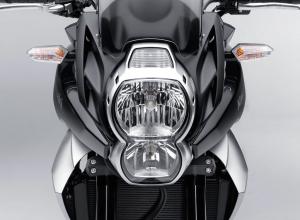 A new
A new
stacked headlight leads the way for the 2010 Versys.
The Versys’ face is as distinctive as ever, now with dual stacked
headlights. Its semi-double-cradle, high-tensile steel frame is adorned
with new plastic, ranging from a re-sculpted fairing, radiator shroud,
engine covers and rear fender.
Blocking the wind is a bigger three-way adjustable windscreen which
protects the rider surprisingly well. Kawasaki also offers a “Tall
Windshield” for $159.95, and a “Vario Windshield” with a wider, taller
base, and adjustable spoiler for $199.95.
This year, new mirrors, turn signals and an LED tail light from the
Z1000 are also included.
The counterbalanced engine is reasonably smooth, but rigid rear
engine mounts were replaced with rubber mounts, and the footpegs now
utilize hollow rubber inserts to further quell vibration.
Synergy on wheels
In recent weeks we’ve thrashed
this bike while strafing corners with some very aggressive motojournos,
and heavily loaded with bags and gear on a frenetic, full-speed-ahead
1,100 mile round-trip tour.
Brenan, who says, the Versys is, "the bike that most riders don't know
they've always wanted."
Or, as Kawasaki’s Sr. Media Relations Coordinator, Jeff Herzog says,
“It's similar to the Z1000.
You have to ride it to understand it and find out how much fun can be
had on one.”
Sure, these guys want to sell motorcycles, but they speak the truth.
Kawasaki now correctly calls the Versys a “sport” bike. As such, it
does not readily run out of cornering clearance, despite respectable
grip from the stock Dunlop D221 Sportmax rubber, and its wide handlebar
aids and abets riders to snap it into corners.
If the road turns rough, the Versys suspension inspires more
confidence than its
ostensibly more sporting stablemates.
Out back its offset laydown Showa shock provides 5.7 inches of
travel, compared to the Ninja 650R or ER-6n’s 4.9 inches. All three
bikes offer stepped spring preload adjustment, but the Versys adds
13-position adjustable rebound.
Up front is a likewise longer inverted 41mm fork cycling through 5.9
inches of travel, and offering stepless adjustable rebound and preload,
compared to the Ninja 650R’s or ER-6n’s basic non-adjustable 4.7 inch
standard hydraulic fork.
The Versys’ front and rear spring rates are progressive. The result
is an initially soft and very compliant feel over stutter bumps, chewed
up pavement, or patched and seamed sections of roads. But when speeds
get competitive, the spring rates firm up, and the bike feels planted
and secure.
 This bike
This bike
likes to corner. The twistier the better.
Our
dyno run for the same engine in 2008 revealed nearly flat torque
from 3,800 to 8,100 rpm, with a peak of almost 60 hp at 8,400 rpm. And
while the midrange is fatter than that of the Ninja 650R or ER-6n, the
engine still eagerly winds to just shy of redline.
Its breadth of torque also means the narrow, 454-lb machine feels
more powerful at lower rpm and rewards the rider with all the drive
that’s needed for tight twisty corners.
Your inner hooligan will be further gratified to learn that the
Versys likes to wheelie with throttle only in the low-ratio first gear,
and in second gear with a little clutch slip to its wide ratio,
cassette-style transmission. It’s much tamer than trying this on an
intensely powerful literbike, but the effect is the same, just at
two-thirds the usual miles per hour.
Further, if you levered on some primo sport rubber, this bike could
reveal another dimension to its personality. We wouldn't hesitate to
take a Versys to a track day.
On track or street, bigger bikes will run away from it on fast
sweepers, but the Versys more than holds its own in the tighter stuff
and is stable at all speeds.
That’s not bad for a bike that’s equally at home fully loaded, on
tour or pressed into mundane duties, or as a beginner bike for new
riders – assuming they respect the power that should be good for nearly
120 mph or so.
We would recommend up-rated brake pads and possibly stiffer brake
lines. The front two-piston Tokico calipers pinching 300mm petal-type
rotors are adequate but lack the degree of whoa-power we’d prefer. Out
back, the 220mm rotor clamped by a single-piston Tokico caliper is up to
the task.
And while the counterbalanced engine is now partly rubber mounted,
mirrors still blur slightly with resonance through the handlebar. The
view can be discerned, but if absolute clarity is needed, one has to
either pull the clutch and let the engine idle, or rev past 7,000 rpm at
which point the buzz diminishes.
 The stock
The stock
saddle has limited range for taller riders but is tolerable.
The standard saddle, while comfortable, pretty much offers limited
range for riders with longer legs. On extended rides, some might wish
for more room to scoot back, just to change positions.
Minor nitpicks aside, this bike is good enough to where it’s not an
overstatement to say it transcends the sum of its parts, especially
considering that at $7,599, the Versys is priced as entry level.
As such, it does lack advanced features found on more expensive
bikes, such as traction control or multi-adjustable ECU maps. Anti-lock
brakes are also not available stateside, as they are in other markets.
A 2-inch lower gel saddle is available for $519.95 for those
challenged by the standard 33.1 inch seat height.
Observed fuel economy from its 5-gallon tank ranged from a low of
about 37 mpg during some heavily loaded, high speed, into-strong-wind
riding, up to 54 mpg.
If the candy colors of previous years had anything to do with some
U.S. riders sticking their noses up at the Versys, we think this year it
looks techno-cool in Metallic Spark Black, and maybe more younger
riders might consider it than in previous years.
In any case, we think the fact that some overlook this bike is too
bad, and possibly revealing.
Just as the Euros were first targeted as recipients for the Versys,
more of them understand something about what constitutes a desirably
functional street bike, while it takes longer for most U.S. riders to
arrive at a similar sensibility.
Eventually U.S. riders do come around, but you’d be wrong if you
thought it was because this is a bike suited for the geriatric set.
Nothing could be further from the truth.
If faced with a budget for only one mid-sized street bike, a lot of
riders – old, young or in between – might want to take a closer look at
the Versys.
Related Reading
2008
Kawasaki Versys First Ride
2008
Kawasaki Versys Road Test
2010
Kawasaki Middlweight and Dual-Purpose Roundup
2010
Kawasaki Ninja 650 vs. 2009 Suzuki GSX650F vs. 2010 Yamaha FZ6R
2009
Naked Middleweight Comparison
Versys is an updated rendition of an already capable bike – one that is
overwhelmingly purchased by experienced motorcyclists – but which could
hit the hot buttons for many more younger riders, if only they knew
what they were missing.
Since its introduction four years ago, some have grappled with
defining this competent but somewhat ambiguous 649cc parallel-Twin
all-round sport motorcycle, which even Kawasaki once listed on its
website under “Dual Purpose.”
Its name is contrived from the words “versatile” and “system,” and
offers some clues.
The Versys takes elements from dual-purpose bikes, standards,
adventure-tourers and sportbikes; sharing characteristics of all, but
neatly fitting into the category of none.
ER-6n,
albeit with a more sophisticated inverted fork, an asymmetrical
“gullwing” aluminum swingarm, retuned engine for broad midrange power,
and with unique looks.
 The Versys
The Versys is led by the ER-6n and followed by the Ninja 650R. Don’t let the green
bike’s racer looks deceive you. The Ninja has nothing on the Versys when
the roads get twisty.
The Versys and ER-6n also share many features with their
fraternal-triplet sibling, the Ninja 650R. But while the Ninja 650R and
ER-6n have identical, peakier versions of the same engine, the Versys
has revised intake and exhaust cams, a 10.6:1 compression ratio instead
of 11.3:1, and redline set 500 rpm lower at 10,500.
While officially considered a “worldwide bike,” the Versys was
designed first for the European and Canadian markets, and launched there
in 2006. Then after many requests from U.S. riders, Kawasaki brought it
in, at first as a 49-state 2008 model. California got its Versys in
2009, when a required evaporative emissions canister was fitted.
Even so, the bike is still much better appreciated in Europe, as
evidenced by its sales performance.
“We also have to realize that the lion's share of Versys are
purchased in Europe where they understand and embrace this type of
motorcycle and where it is ridden enthusiastically,” says Kawasaki’s
Public Relations Supervisor, Russ Brenan.
The American motorcycle press never
underappreciated the Versys, however, and some publications loaded
it with accolades, saying it is well suited for anyone, be they new or
experienced or somewhere in between.
recommendation was received just like a lot of advice so often is from
an experienced elder – disregarded by the kids who know better!
To wit, Kawasaki says 64% of U.S. Versys purchasers are age 45 and
older, and 62% have more than five years riding experience.
In contrast, riders under age 25 comprise just 2% of U.S. Versys
buyers, and those age 25 to 34 represent a mere 8%.
We might euphemistically attribute this to different priorities
between younger U.S. riders and their European counterparts, including
possible objections over its “funky” appearance.
But whether its looks will enhance the image you think you represent,
or not, the Versys is aptly named.
Its is good at nearly any kind of on-road riding you can throw at it –
from grocery getting, to commuting, to sport riding, to exploring even
the roughest of roads nearby, or on tour.
 The 2010 The 2010 Versys received a styling overhaul while leaving its functional aspects – engine, 6-speed cassette transmission and brakes – intact. |
This year’s model received mostly stylistic bodywork tweaks, which
while subtle, are not few.
 A new
A new stacked headlight leads the way for the 2010 Versys.
The Versys’ face is as distinctive as ever, now with dual stacked
headlights. Its semi-double-cradle, high-tensile steel frame is adorned
with new plastic, ranging from a re-sculpted fairing, radiator shroud,
engine covers and rear fender.
Blocking the wind is a bigger three-way adjustable windscreen which
protects the rider surprisingly well. Kawasaki also offers a “Tall
Windshield” for $159.95, and a “Vario Windshield” with a wider, taller
base, and adjustable spoiler for $199.95.
This year, new mirrors, turn signals and an LED tail light from the
Z1000 are also included.
The counterbalanced engine is reasonably smooth, but rigid rear
engine mounts were replaced with rubber mounts, and the footpegs now
utilize hollow rubber inserts to further quell vibration.
| Ortlieb Motorcycle Luggage Review |
| Waterproof means waterproof! We decided the Versys would b a great bike to ride up the Pacific Coast Highway from LA to the TTXGP in Sonoma, Calif. from May 14-16. We’ve previously enjoyed Kawasaki’s accessory hard luggage for the Versys, but it wasn’t available in time for this trip. So we went looking for durable, serviceable alternatives. Upon calling Ortlieb USA in Washington state, we were pleased to learn we could get a full complement of waterproof soft bags on short notice. <table align="center"> <tr> <td> 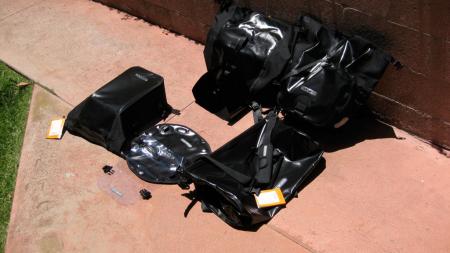 Complete Complete ensemble: Pair of saddlebags, duffel-shaped “Rack-Pack,” tank bag, base, and clear cover. All 100% waterproof. These bags are available in high-visibility colors. I chose the Johnny Cash look to match the Versys. </td></tr></table> Their design may not include outside pockets for you to lose your do-dads in, but that’s what small extra bags are for. And when the going gets tough, these large-volume primary bags are otherwise hard to beat. For example, if you’ve ever had ordinary coated pack cloth bags and gotten caught in the rain, you may know how easy it is to get water into your clothes, gear, and anything else you might have packed. Ortlieb’s Euro-designed bags prevent this by using the time-honored method that whitewater kayakers and their ilk use to keep their stuff dry. They are made of tough waterproof coated fabrics specially designed to Ortlieb’s specs, and assembled using a high frequency welding process. The bags are highly effective and have a solid reputation among serious outdoor travelers of all sorts. They resist water infiltration by having no zippers to leak, and only one opening per bag – which closes utilizing the roll-top method to make them air-tight to the point that they could float if they had to. They are made to resist up to 100,000 folds (to the roll-top), and meet stringent engineering criteria Ortlieb sets for water-tightness, tear and abrasion resistance. Assuming you roll them closed correctly, any splashed or falling water should have no effect on their dryness-factor, and this means rain covers are unnecessary. As experienced riders may know, rain covers can leak, blow off, or get lost. It was a relief for us not to have to deal with them. 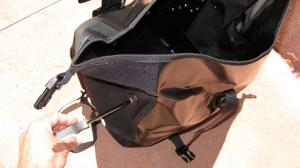 Brief Brief assembly required for the saddlebags only. Essentially, the inner stiffener panels are connected by rust-resistant steel screws through black plastic buttons. It took 10 minutes to put them together. For main luggage duties, we strapped on a set of basic black saddlebags ($203.50) that can hold 47 liters of stuff. Since we needed extra storage for camping gear and equipment, we also got a Rack-Pack – essentially a roll-top, waterproof duffel bag. Prices range from $77 to $104.50, depending on which of four sizes (24 to 89 liters) are ordered. We selected the size large 49-liter version that retails for $93.50. Additionally, a basic 15-liter Tank Bag was procured. The rectangular tank bag is also an internally stiffened drybag. It buckles via quick-connect plastic fasteners to a flexible base lined with several strong magnets. Although the Versys’ steel gas tank was shrouded by plastic fairing sides, the magnets that did touch steel were strong enough to secure the bag, but we augmented the system with an additional bungee to the bag’s front, just in case. The tank bag’s large, clear, roll-top map pocket is equally waterproof, and buckles either to the top of the tank bag, or to the magnetic base alone, if you want to travel light. Also, just to keep everything extra secure, we added bungees and straps all around. These were probably over-doing it, but better too much than not enough <table align="center"> <tr> <td> 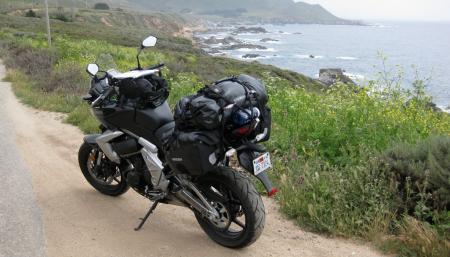 All All dressed up, and everywhere to go. The Versys was back in black, posed momentarily heading the wrong way alongside the beautiful Pacific on the road just south of Big Sur. </td></tr></table> So did the stuff work? Sure did. Coming back via I-5 from Sonoma, we left in rain. Nice, steady, penetrating rain. It pretty much fell on and off for most of the 430-mile trip down to L.A. Upon finally reaching home, everything in the bags was dry, despite occasional hurricane-level rainy wind blasts. What more could you ask for? These bags are great, and we’ll be using them any time we want reliable soft luggage to venture near or far. –JC |
In recent weeks we’ve thrashed
this bike while strafing corners with some very aggressive motojournos,
and heavily loaded with bags and gear on a frenetic, full-speed-ahead
1,100 mile round-trip tour.
Brenan, who says, the Versys is, "the bike that most riders don't know
they've always wanted."
Or, as Kawasaki’s Sr. Media Relations Coordinator, Jeff Herzog says,
“It's similar to the Z1000.
You have to ride it to understand it and find out how much fun can be
had on one.”
Sure, these guys want to sell motorcycles, but they speak the truth.
Kawasaki now correctly calls the Versys a “sport” bike. As such, it
does not readily run out of cornering clearance, despite respectable
grip from the stock Dunlop D221 Sportmax rubber, and its wide handlebar
aids and abets riders to snap it into corners.
If the road turns rough, the Versys suspension inspires more
confidence than its
ostensibly more sporting stablemates.
Out back its offset laydown Showa shock provides 5.7 inches of
travel, compared to the Ninja 650R or ER-6n’s 4.9 inches. All three
bikes offer stepped spring preload adjustment, but the Versys adds
13-position adjustable rebound.
Up front is a likewise longer inverted 41mm fork cycling through 5.9
inches of travel, and offering stepless adjustable rebound and preload,
compared to the Ninja 650R’s or ER-6n’s basic non-adjustable 4.7 inch
standard hydraulic fork.
The Versys’ front and rear spring rates are progressive. The result
is an initially soft and very compliant feel over stutter bumps, chewed
up pavement, or patched and seamed sections of roads. But when speeds
get competitive, the spring rates firm up, and the bike feels planted
and secure.
 This bike
This bike likes to corner. The twistier the better.
Our
dyno run for the same engine in 2008 revealed nearly flat torque
from 3,800 to 8,100 rpm, with a peak of almost 60 hp at 8,400 rpm. And
while the midrange is fatter than that of the Ninja 650R or ER-6n, the
engine still eagerly winds to just shy of redline.
Its breadth of torque also means the narrow, 454-lb machine feels
more powerful at lower rpm and rewards the rider with all the drive
that’s needed for tight twisty corners.
Your inner hooligan will be further gratified to learn that the
Versys likes to wheelie with throttle only in the low-ratio first gear,
and in second gear with a little clutch slip to its wide ratio,
cassette-style transmission. It’s much tamer than trying this on an
intensely powerful literbike, but the effect is the same, just at
two-thirds the usual miles per hour.
Further, if you levered on some primo sport rubber, this bike could
reveal another dimension to its personality. We wouldn't hesitate to
take a Versys to a track day.
On track or street, bigger bikes will run away from it on fast
sweepers, but the Versys more than holds its own in the tighter stuff
and is stable at all speeds.
That’s not bad for a bike that’s equally at home fully loaded, on
tour or pressed into mundane duties, or as a beginner bike for new
riders – assuming they respect the power that should be good for nearly
120 mph or so.
We would recommend up-rated brake pads and possibly stiffer brake
lines. The front two-piston Tokico calipers pinching 300mm petal-type
rotors are adequate but lack the degree of whoa-power we’d prefer. Out
back, the 220mm rotor clamped by a single-piston Tokico caliper is up to
the task.
And while the counterbalanced engine is now partly rubber mounted,
mirrors still blur slightly with resonance through the handlebar. The
view can be discerned, but if absolute clarity is needed, one has to
either pull the clutch and let the engine idle, or rev past 7,000 rpm at
which point the buzz diminishes.
 The stock
The stock saddle has limited range for taller riders but is tolerable.
The standard saddle, while comfortable, pretty much offers limited
range for riders with longer legs. On extended rides, some might wish
for more room to scoot back, just to change positions.
Minor nitpicks aside, this bike is good enough to where it’s not an
overstatement to say it transcends the sum of its parts, especially
considering that at $7,599, the Versys is priced as entry level.
As such, it does lack advanced features found on more expensive
bikes, such as traction control or multi-adjustable ECU maps. Anti-lock
brakes are also not available stateside, as they are in other markets.
A 2-inch lower gel saddle is available for $519.95 for those
challenged by the standard 33.1 inch seat height.
Observed fuel economy from its 5-gallon tank ranged from a low of
about 37 mpg during some heavily loaded, high speed, into-strong-wind
riding, up to 54 mpg.
If the candy colors of previous years had anything to do with some
U.S. riders sticking their noses up at the Versys, we think this year it
looks techno-cool in Metallic Spark Black, and maybe more younger
riders might consider it than in previous years.
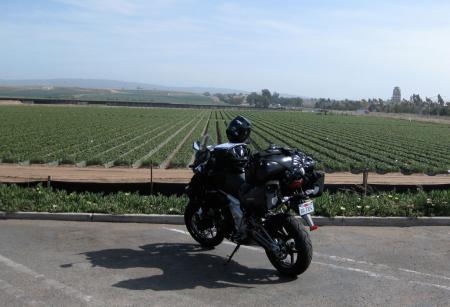 Stopping Stopping to look at America’s bread basket while packing everything but the kitchen sink. |
bad, and possibly revealing.
Just as the Euros were first targeted as recipients for the Versys,
more of them understand something about what constitutes a desirably
functional street bike, while it takes longer for most U.S. riders to
arrive at a similar sensibility.
Eventually U.S. riders do come around, but you’d be wrong if you
thought it was because this is a bike suited for the geriatric set.
Nothing could be further from the truth.
If faced with a budget for only one mid-sized street bike, a lot of
riders – old, young or in between – might want to take a closer look at
the Versys.
Related Reading
2008
Kawasaki Versys First Ride
2008
Kawasaki Versys Road Test
2010
Kawasaki Middlweight and Dual-Purpose Roundup
2010
Kawasaki Ninja 650 vs. 2009 Suzuki GSX650F vs. 2010 Yamaha FZ6R
2009
Naked Middleweight Comparison
ganahsokmo- Join date : 16/01/2010
Age : 43
 Similar topics
Similar topics» 2010 Kawasaki ZX-10R Review
» 2010 Kawasaki Z1000 Review
» 2010 Kawasaki Concours 14 Review
» 2010 Kawasaki KLX110 & KLX110L Review
» 2010 Kawasaki Ninja 650R Review
» 2010 Kawasaki Z1000 Review
» 2010 Kawasaki Concours 14 Review
» 2010 Kawasaki KLX110 & KLX110L Review
» 2010 Kawasaki Ninja 650R Review
Page 1 of 1
Permissions in this forum:
You cannot reply to topics in this forum

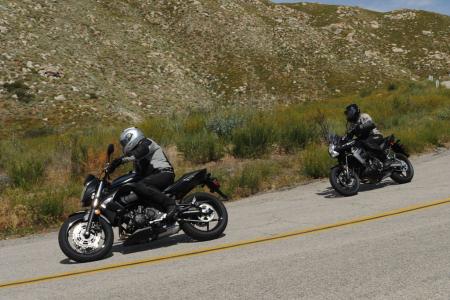 See the
See the 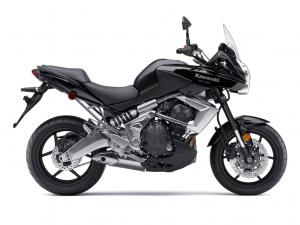 The
The 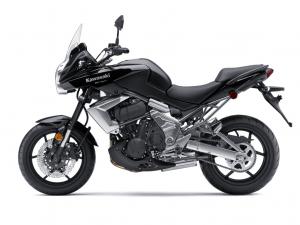 On the
On the 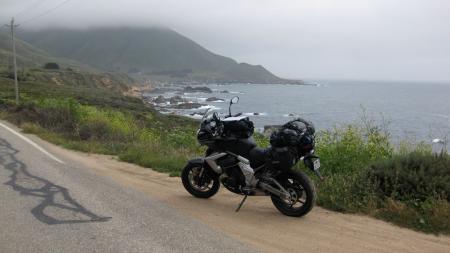 Loaded
Loaded 
